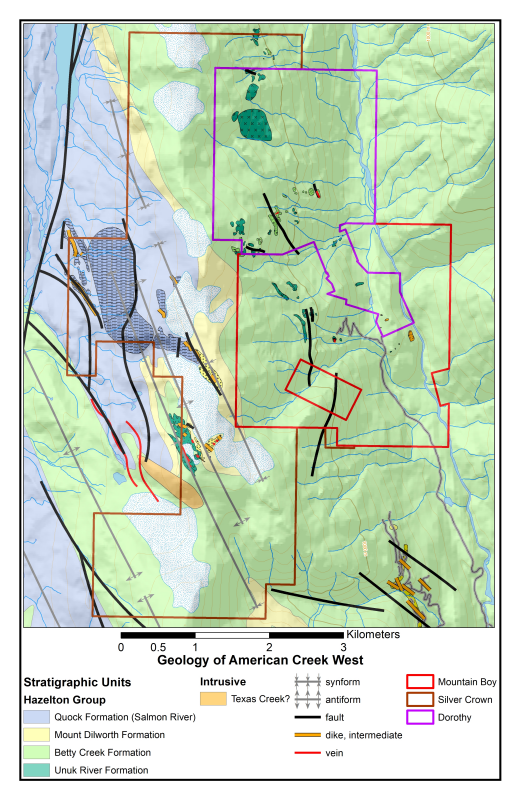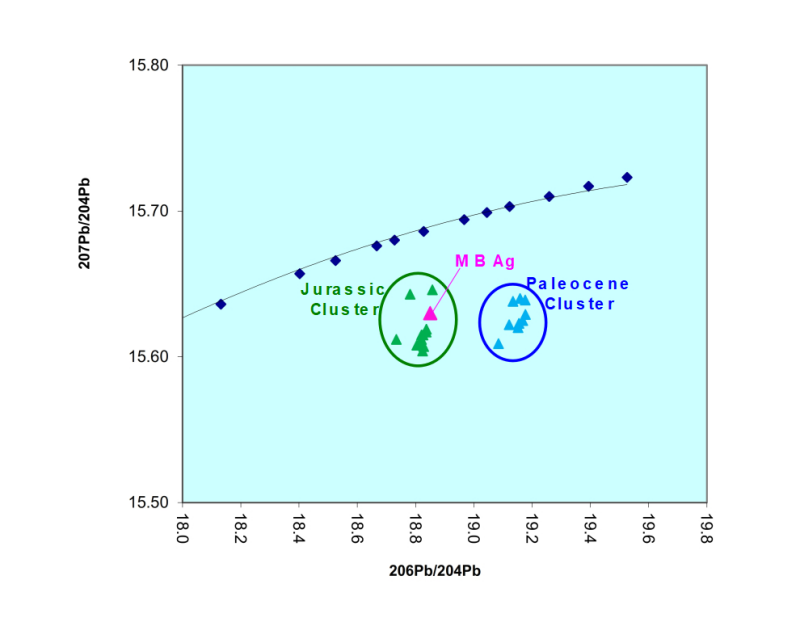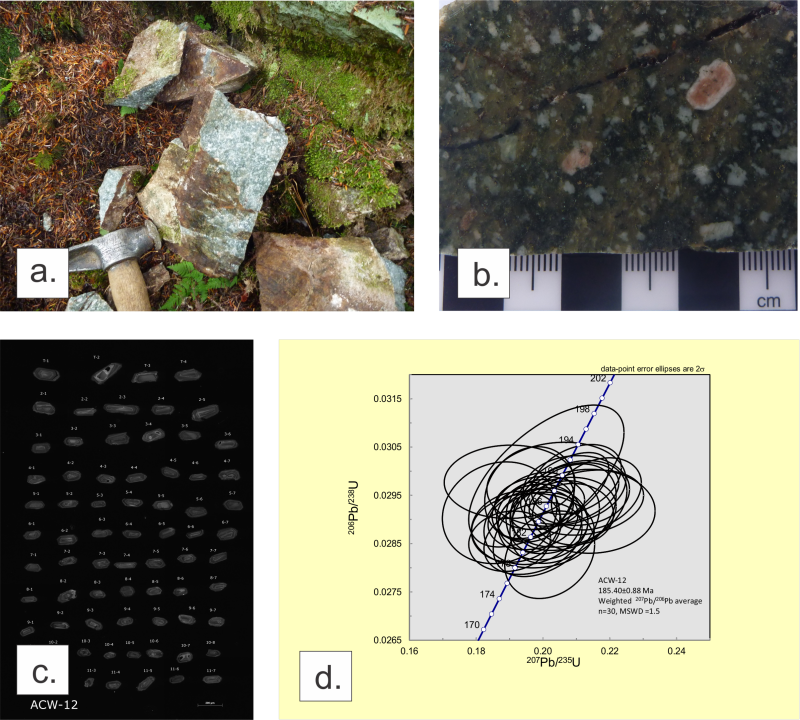Mountain Boy Confirms District Scale Silver-Gold Potential of The American Creek Project
(TheNewswire)

Vancouver, BC – TheNewswire - May 21st, 2020 – Mountain Boy Minerals Ltd (“Mountain Boy” or the “Company”) (TSXV:MTB) (Frankfurt:M9UA) is pleased to provide a summary of its completed geological model for the American Creek West Project.
Recent lead isotope analytical results provide additional support for an emerging geological model of Mountain Boys’ American Creek West Project (ACW). The model points to district-scale silver-gold potential. The 26 square kilometer (2,600 ha) property, located 22 kms north of Stewart, has a rich mining history: There are 17 recorded past producers on or within 6 km of the property. The region has been explored by several companies, many focused on the historic occurrences. The ACW project is readily accessible by gravel roads off Highway 37A.
By consolidating the properties and assembling a large historical geological database from numerous sources, Mountain Boy is taking the first ever comprehensive view of this richly-mineralized region. The emerging geological model holds that the various mineralized occurrences are surface expressions of a large geological system. That system is analogous to the Premier District, located immediately west of the American Creek property.
We now have compelling evidence that American Creek hosts a distinct geological system similar to Premier in age, geological setting and scale. That model suggests that the many mineralized occurrences are related and that the possibility exists for a larger mineralized body beneath the surface.
Planning and budgeting are now wrapping up for the first phase of the field season which will fine tune the model and define drill targets in anticipation of a second phase. Further details will be announced shortly.
New Geological Model for an Historic Silver-Gold District
The recently consolidated American Creek Project encompasses most of the west side of the American Creek corridor (Figure 1). Compilation of historic data, recent research, and current exploration has led to a refined concept of the geology and mineralization of the American Creek project. The geological model is presented herein;
The current working deposit model includes two episodes and styles of mineralization:
- The first style is related to oceanic arc subduction in the Early Jurassic resulting in porphyry intrusive activity and volcanism. Hydrothermal activity generated by this magmatic activity has resulted in porphyry mineralization and multiple pulses of epithermal, structurally controlled and replacement mineralization telescoping off the porphyry system.
- The second style is related to continental arc subduction during the Cretaceous and consists of structurally controlled mineralization associated with the emplacement of Middle Eocene dyke swarms and stocks of the Coast Plutonic Complex.
The geological model was conceptualized from historic work, including drilling, sampling, petrography, X-ray diffraction, scanning electron microscopy, and geophysics and more recent property scale mapping, sampling, U-Pb zircon geochronology, Pb isotope analysis, and petrography.
Geological mapping demonstrates that the project area is dominantly underlain by Lower Jurassic Lower Hazelton Group rocks (Unuk River and Betty Creek Formations). The west central portion of the claims are underlain by Lower to Middle Jurassic Mount Dilworth formation rocks, which are overlain by Middle to Upper Jurassic Salmon River formation. Historic airborne geophysical magnetic data helped refine geological contacts, which were then ground-truthed.
Regional and project scale structures are integral to the geologic understanding and model. The rocks have undergone ductile deformation related to the mid-Cretaceous Skeena-thrust-and-fold belt which has resulted in a series of anticlines and synclines, namely the American Creek anticline and the Spider anticline. Both anticlines are north-northwest trending. The American Creek West project lies on the west limb of the American Creek anticline and the east limb of the Spider anticline (Figure 2).
Samples taken from the historic Mountain Boy mine area, which consisted of high-grade silver mineralization, were studied in a thesis at the University of Calgary (Kruchkowski, 2000). Kruchkowski found that these samples are characterized by an ore mineralogy suite that in part defines intermediate epithermal deposits (Sillitoe and Hedenquist, 2003). Ore minerals, such as acanthite, Ag-sulfosalts, low Fe sphalerite, galena, tetrahedrite-tennantite and chalcopyrite were identified in the field; the correlating assays to these samples exemplify the poly-metallic nature of the prospect.
Optical petrographic analysis, X-ray diffraction analysis, and scanning electron microscopy analysis demonstrated that these veins share a common mineralogy, in that all contain various amounts of quartz/jasper, barite, and carbonate. In addition to the ore mineralogy, several vein textures that further support the intermediate epithermal model were observed, such as open space filling textures, crustiform banding, carbonate replacement, bladed barite and calcite.
A recent lead isotope analysis from galena taken from the Mountain Boy mine provides a fingerprint of the mineralization. Historic lead isotope analyses of numerous deposits in the Stewart camp (Godwin et al., 1991) identified two data clusters. One cluster was interpreted to be related to Jurassic aged mineralization; the other cluster was interpreted to be related to Paleocene aged mineralization. The sample from the Mountain Boy mine plots with the Jurassic aged cluster, the same age as the historic Premier mine (Figure 3).
U-Pb isotopic analysis of zircons from a sample of the American Creek intrusion, using laser ablation, yielded a middle Pliensbachian age (ca. 185.4±0.88 Ma; Figure 4). Petrographic analysis of the intrusion characterizes the sample as a porphyritic latite with sericite-chlorite-calcite-muscovite alteration, cross cut by veins of quartz-chlorite-calcite and sericite veinlets (Figure 4).
The new discovery area that hosts the second style of mineralization is located west of the Mountain Boy mine. It was covered by glaciers during the early years of exploration along American Creek and has not seen recorded work in modern times. This style of mineralization consists of layered, locally sheeted, quartz-carbonate-sulphide veins. Sulfides are sparse to abundant and appear as coarse grains, fine disseminations, massive to semi-massive veining, and stringers. Samples are described as having galena, sphalerite and pyrite mineralization associated with quartz ± calcite veining. At this time, this style of mineralization is hypothesized to be related to a Paleocene dyke swarm. This age of mineralization is well documented in the region. Galena from this new zone will be further analysed to test this concept.
The geological setting, style of mineralization, nature of the intrusive body and the scale of the system has many similarities to the Premier District, located immediately to the west. The Premier District produced 2.5 million ounces of gold and 50 million ounces of silver from 1918 to 1996. Ascot Resources Ltd recently completed a feasibility study for a restart plan for the Premier Mine. (Ascot News Release, April 15, 2020).
In summary, there is significant opportunity for one or more major discoveries on Mountain Boy’s American Creek project. Epithermal vein deposits like this generally have many mineralized ore shoots along multiple structures. While numerous veins have been identified at surface, the work now underway is the first comprehensive look at the region. The work so far has provided compelling evidence that the veins continue to depth, as they do in similar settings, such as the Premier District.
Maps & Figures
Figure 1 – Geology and Claim Map of American Creek West
Figure 2 – Cross section through American Creek West
Figure 3 – Lead isotope data (From Godwin et al., 1991); ACW mineralization plots with other known Jurassic aged deposits
Figure 4 - a.) Sample ACW-12 in the field. b.) Close-up photograph of sample ACW-12. c.) Cathodoluminescence image of zircon collected from sample ACW-12. d.) Concordia plot for sample ACW-12.
The technical disclosure in this release has been read and approved by Andrew Wilkins, B.Sc., P.Geo., a qualified person as defined in National Instrument 43-101.
On behalf of the Board of Directors:
Lawrence Roulston
President & CEO
For further information, contact:
Nancy Curry
VP Corporate Development
(604) 220-2971
Neither the TSX Venture Exchange nor its Regulation Services Provider (as that term is defined in the policies of the TSX Venture Exchange) accepts responsibility for the adequacy or accuracy of this release.
Copyright (c) 2020 TheNewswire - All rights reserved.



